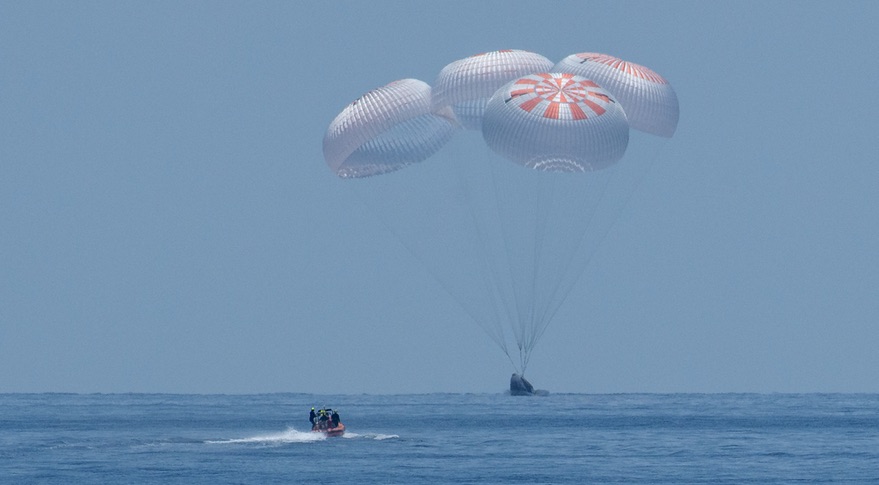Products You May Like
WASHINGTON — NASA and SpaceX are finalizing reviews of minor changes to the Crew Dragon spacecraft that they expect will be complete before the first operational mission launches to the International Space Station at the end of October.
During a series of press conferences Sept. 29 about the upcoming Crew-1 mission to the ISS, officials said they were incorporating lessons learned from the Demo-2 flight of the Crew Dragon this summer into the design of the spacecraft.
One issue involves the heat shield on the spacecraft. “We found on a tile a little bit more erosion than we wanted to see,” said Hans Koenigsmann, vice president of build and flight reliability at SpaceX. The problem appeared to be with how air flowed around “tension ties,” or bolts that link the capsule to the trunk section of the spacecraft that is jettisoned just before reentry. “We saw some flow phenomenon that we really didn’t expect, and we saw erosion to be deeper than we anticipated.”
He emphasized that erosion was limited to a very small area of the heat shield, and didn’t put the Demo-2 crew in jeopardy. “It’s relatively easy to fix,” he said, by using a more erosion-resistant material for the tiles around the four tension ties. That change was tested in an arcjet chamber at the Ames Research Center last week “and it came out great.”
A second issue was with parachute deployment, which took place within what Koenigsmann called the “allowable box” for reentry but a little lower than expected. SpaceX is changing an instrument that uses barometric pressure to determine altitude to correct the problem.
Those changes have been the major issues before NASA formally certifies the Crew Dragon spacecraft for operational missions. “The big chunk of the certification is in those upgrades,” said Kathy Lueders, NASA associate administrator for human exploration and operations. Other focus areas include new capabilities added to the Crew-1 mission, such as being able to dock with two different ports on the station.
Most of the rest of the certification work is completed, she said, including a program-level certification review. “We’re just in the process of finalizing the last few pieces of our documentation needed to close our human rating certification plans,” she said, work she expected to completed in the next week to 10 days. A “final final” certification will take place at the flight readiness review for the Crew-1 mission, about a week before launch.
Another change for the Crew-1 mission will address an issue after splashdown on the Demo-2 mission, when dozens of private boats swarmed around the spacecraft. Koenigsmann said NASA and SpaceX is closely coordinating with the U.S. Coast Guard to maintain a 16-kilometer “keep out zone” around the splashdown site, to be patrolled by additional Coast Guard vessels.
The Crew Dragon mission that will fly the Crew-1 mission features other upgrades, including the ability to support four people and remain in orbit for 210 days. The spacecraft also features an improved backshell that will increase the wind limits for reentry, said Anthony Vareha, the lead NASA flight director for the mission. For Demo-2, he said, there was just one chance in seven of having acceptable winds, but “we got it right on the first try.” For Crew-1, that will improve to one in four.
The day before the briefings, NASA announced it was delaying the Crew-1 launch by eight days to Oct. 31. Part of the reason for the slip was to wrap up that certification work, as well as provide more time between the arrival and departure of Soyuz spacecraft in mid-October and the Crew-1 mission. “It’s a very busy October for us,” Lueders said.
Another factor in the announcement in the delay was to provide more time to track down an air leak on the station. Shortly before the briefings started, NASA announced the rate of the leak had increased, and had been isolated to the Zvezda module in the station. “We think there’s something going on there,” said Kenny Todd, deputy manager of the ISS program at NASA.
That leak does not pose a safety issue for the crew, and Todd said additional air bottles will be flown to the station on a Cygnus cargo spacecraft scheduled for launch Oct. 1. It also should not affect the Crew-1 mission, he added. “We’ll be OK out to the spring of next year” based on the current leak rate, he said. “This is not necessarily a near-term problem, as long as the leak rate stays at where it’s at today.”
The four astronauts who will fly on the Crew-1 mission — NASA astronauts Mike Hopkins, Victor Glover and Shannon Walker, and JAXA astronaut Soichi Noguchi — said they were ready for the flight, having finished all their training for the mission except for a few final simulator sessions. The astronauts announced that, following the tradition of the Demo-2 mission, where astronauts Bob Behnken and Doug Hurley named their Crew Dragon spacecraft “Endeavour,” they had selected the name “Resilience” for their spacecraft.
“I think all of us can agree that 2020 has certainly been a challenging year,” Hopkins said. “The name ‘Resilience’ is really in honor of the SpaceX and NASA teams and, quite frankly, it’s in honor of our families, our colleagues, our fellow citizens, international partners and leaders, who have all shown that same quality, that same characteristic through these difficult times.”
